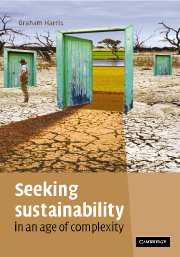Book contents
- Frontmatter
- Contents
- Acknowledgements
- 1 Preamble: the world we are in
- 2 Complexity and complex systems
- 3 New science, new tools, new challenges
- 4 The complexity of ecology
- 5 The generation of complexity
- 6 Micro-interactions and macro-constraints
- 7 A sense of place
- 8 Created landscapes and our changing sense of place
- 9 Catchment form and function
- 10 Catchment loads: ecosystem impacts
- 11 Change detection, monitoring and prediction
- 12 Evidence, uncertainty and risk
- 13 Modified landscapes: biodiversity
- 14 Function in fragmented landscapes
- 15 Environmental flows
- 16 Evidence for global change
- 17 Values and beliefs
- 18 Managing environmental, social and economic systems
- 19 Linking multiple capitals in a changing world
- 20 Community, capacity, collaboration and innovation
- 21 A new environmental paradigm
- 22 Emergent problems and emerging solutions: developing an ‘ecolophysics’?
- 23 Avoiding collapse
- Index
11 - Change detection, monitoring and prediction
Published online by Cambridge University Press: 21 March 2011
- Frontmatter
- Contents
- Acknowledgements
- 1 Preamble: the world we are in
- 2 Complexity and complex systems
- 3 New science, new tools, new challenges
- 4 The complexity of ecology
- 5 The generation of complexity
- 6 Micro-interactions and macro-constraints
- 7 A sense of place
- 8 Created landscapes and our changing sense of place
- 9 Catchment form and function
- 10 Catchment loads: ecosystem impacts
- 11 Change detection, monitoring and prediction
- 12 Evidence, uncertainty and risk
- 13 Modified landscapes: biodiversity
- 14 Function in fragmented landscapes
- 15 Environmental flows
- 16 Evidence for global change
- 17 Values and beliefs
- 18 Managing environmental, social and economic systems
- 19 Linking multiple capitals in a changing world
- 20 Community, capacity, collaboration and innovation
- 21 A new environmental paradigm
- 22 Emergent problems and emerging solutions: developing an ‘ecolophysics’?
- 23 Avoiding collapse
- Index
Summary
The implications of the new paradigms for monitoring and prediction: new techniques for modelling ecosystems.
If we are trying to understand pattern and process in the natural world, if we are trying to determine what we know and whether change has occurred, and if we are trying to figure out what to do about it, then unfortunately we can only rely on samples to provide the evidence – snapshots of reality. We collect data in various ways, usually at our convenience: often weekly, almost never on Mondays or Fridays, and rarely for more than a couple of years because of the tenure of governments, programmes, grants and graduate students. We do have some new technologies that will revolutionise our understanding of environmental pattern and process. From satellites and spacecraft we can image the entire globe and from various automatic sensors we can obtain time series of data from the depths of the oceans. Nevertheless, we are forced to infer pattern and process and to take decisions based on parlous sources of information. Surprisingly, perhaps, as the global environmental problems grow, we are actually collecting fewer data in some cases than we were a decade ago because of smaller governments, reduced funding, de-skilling and cuts to government programmes. We are flying almost blind while arguing endlessly about the course we are on and not looking out for hazards and risks up ahead.
- Type
- Chapter
- Information
- Seeking Sustainability in an Age of Complexity , pp. 140 - 161Publisher: Cambridge University PressPrint publication year: 2007



